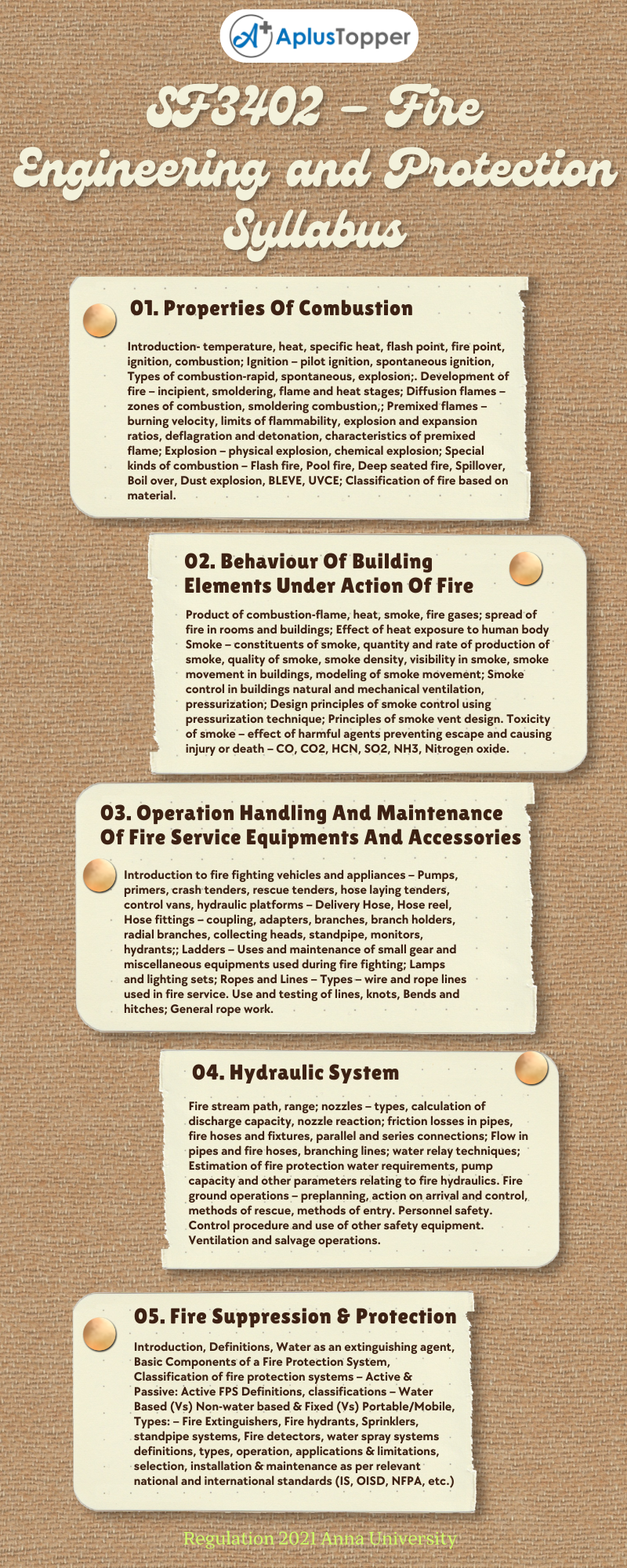In this article, we tried our best to provide the syllabus regarding Anna University awarding the B.E Safety and Fire Engineering syllabus Semester IV subject Fire Engineering and Protection.
We include more details along with the syllabus of SF3402 – Fire Engineering and Protection, by the expertise ones with required textbooks and references for additional purposes to make your preparation easy. You just simply follow the unit-wise syllabus to excel in academics. Hope this information is useful. Comment below if you have any doubts relevant to the subject in the given below comment box. Kindly share it with your friends.
If you want to know more about the B.E Safety And Fire Engineering syllabus connected to an affiliated institution’s four-year undergraduate degree program. We provide you with a detailed Year-wise, semester-wise, and Subject-wise syllabus in the following link B.E Safety And Fire Engineering Syllabus Regulation 2021 Anna University.
Aim Of Objectives:
- Anticipate, identify and evaluate hazardous conditions and practices.
- Develop hazard control designs, methods, procedures, and programs.
- Illustrate the basic concepts and techniques of modern reliability engineering tools.
- To provide the students an illustration of significance of the Fire Engineering profession in the protection life, property and environment.
- To understand the importance of life safety in building fire and method of evacuation.
SF3402 – Fire Engineering and Protection Syllabus
Unit – I: Properties Of Combustion
Introduction- temperature, heat, specific heat, flash point, fire point, ignition, combustion; Ignition – pilot ignition, spontaneous ignition, Types of combustion-rapid, spontaneous, explosion;. Development of fire – incipient, smoldering, flame and heat stages; Diffusion flames – zones of combustion, smoldering combustion,; Premixed flames – burning velocity, limits of flammability, explosion and expansion ratios, deflagration and detonation, characteristics of premixed flame; Explosion – physical explosion, chemical explosion; Special kinds of combustion – Flash fire, Pool fire, Deep seated fire, Spillover, Boil over, Dust explosion, BLEVE, UVCE; Classification of fire based on material.
Unit – II: Behaviour Of Building Elements Under Action Of Fire
Product of combustion-flame, heat, smoke, fire gases; spread of fire in rooms and buildings; Effect of heat exposure to human body Smoke – constituents of smoke, quantity and rate of production of smoke, quality of smoke, smoke density, visibility in smoke, smoke movement in buildings, modeling of smoke movement; Smoke control in buildings natural and mechanical ventilation, pressurization; Design principles of smoke control using pressurization technique; Principles of smoke vent design. Toxicity of smoke – effect of harmful agents preventing escape and causing injury or death – CO, CO2, HCN, SO2, NH3, Nitrogen oxide.

Unit – III: Operation Handling And Maintenance Of Fire Service Equipments And Accessories
Introduction to fire fighting vehicles and appliances – Pumps, primers, crash tenders, rescue tenders, hose laying tenders, control vans, hydraulic platforms – Delivery Hose, Hose reel, Hose fittings – coupling, adapters, branches, branch holders, radial branches, collecting heads, standpipe, monitors, hydrants;; Ladders – Uses and maintenance of small gear and miscellaneous equipments used during fire fighting; Lamps and lighting sets; Ropes and Lines – Types – wire and rope lines used in fire service. Use and testing of lines, knots, Bends and hitches; General rope work.
Unit – IV: Hydraulic System
Fire stream path, range; nozzles – types, calculation of discharge capacity, nozzle reaction; friction losses in pipes, fire hoses and fixtures, parallel and series connections; Flow in pipes and fire hoses, branching lines; water relay techniques; Estimation of fire protection water requirements, pump capacity and other parameters relating to fire hydraulics. Fire ground operations – preplanning, action on arrival and control, methods of rescue, methods of entry. Personnel safety. Control procedure and use of other safety equipment. Ventilation and salvage operations.
Unit – V: Fire Suppression & Protection
Introduction, Definitions, Water as an extinguishing agent, Basic Components of a Fire Protection System, Classification of fire protection systems – Active & Passive: Active FPS Definitions, classifications – Water Based (Vs) Non-water based & Fixed (Vs) Portable/Mobile, Types: – Fire Extinguishers, Fire hydrants, Sprinklers, standpipe systems, Fire detectors, water spray systems definitions, types, operation, applications & limitations, selection, installation & maintenance as per relevant national and international standards (IS, OISD, NFPA, etc.)
Text Books:
- Gupta, R.S., “Hand Book of Fire Technology” Orient Longman, Bombay 1977.
- Barendra Mohan Sen, “Fire protection and prevention the essential handbook”. UBS Publishers’ Distributors Pvt. Ltd, 2009.
References:
- Ron Hirst, “Underdowns Practical Fire Precautions”, Gower Publishing Company Ltd., England, 1989.
- Jain V.K. “Fire safety in buildings” (2nd ed.). New Age International (P) Ltd., New Delhi. 2010.
- Barendra Mohan Sen,” Fire protection and prevention the essential handbook”, UBS publishers and Dist., New Delhi, 2013.
- “Jain V.K., “Fire Safety in Buildings”, New Age International (P) Ltd., New Delhi, 1996.
- N F P A. Fire Protection Handbook. 20th Edition, 2008.
Related Posts On Semester – IV:
- MA3352 – Probability and Linear Algebra
- SF3401 – Occupational Health and Hygiene
- CE3491 – Strength of Materials
- GE3451 – Environmental Sciences and Sustainability
Must Read:
